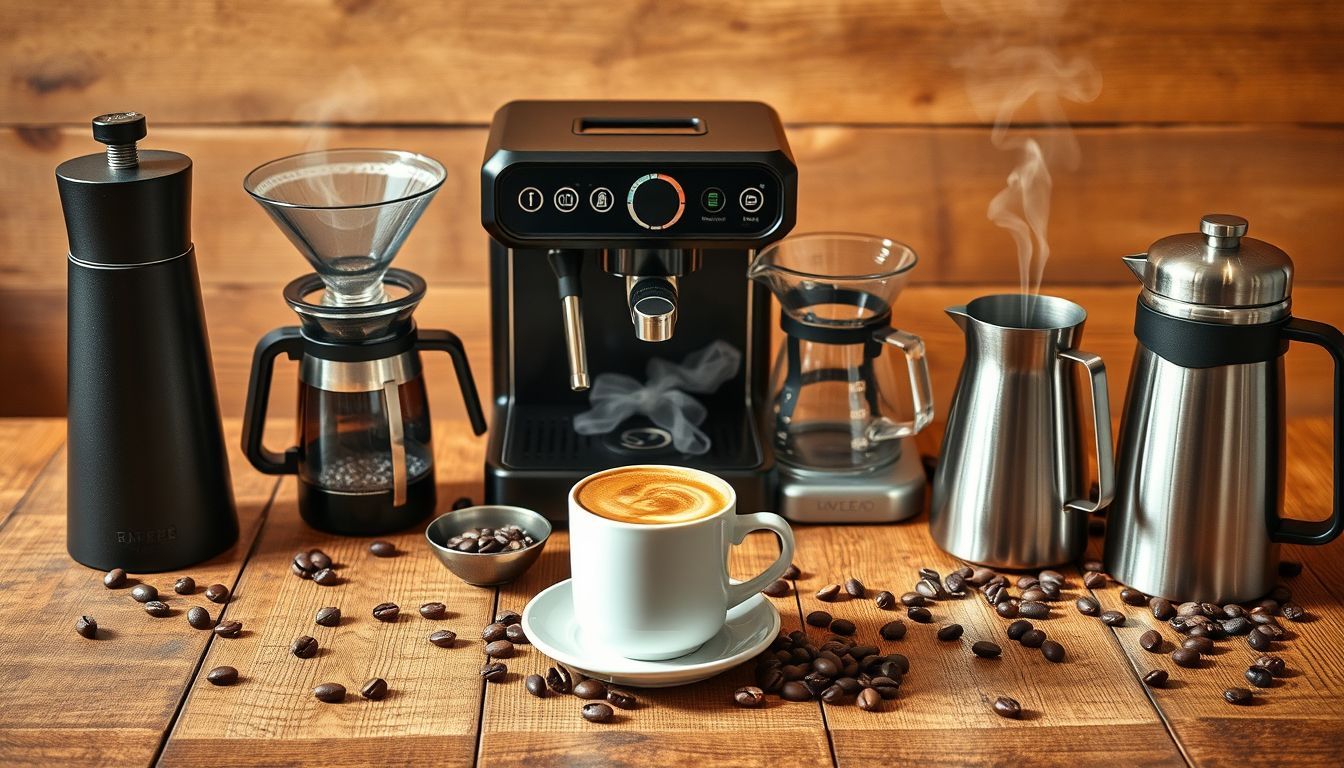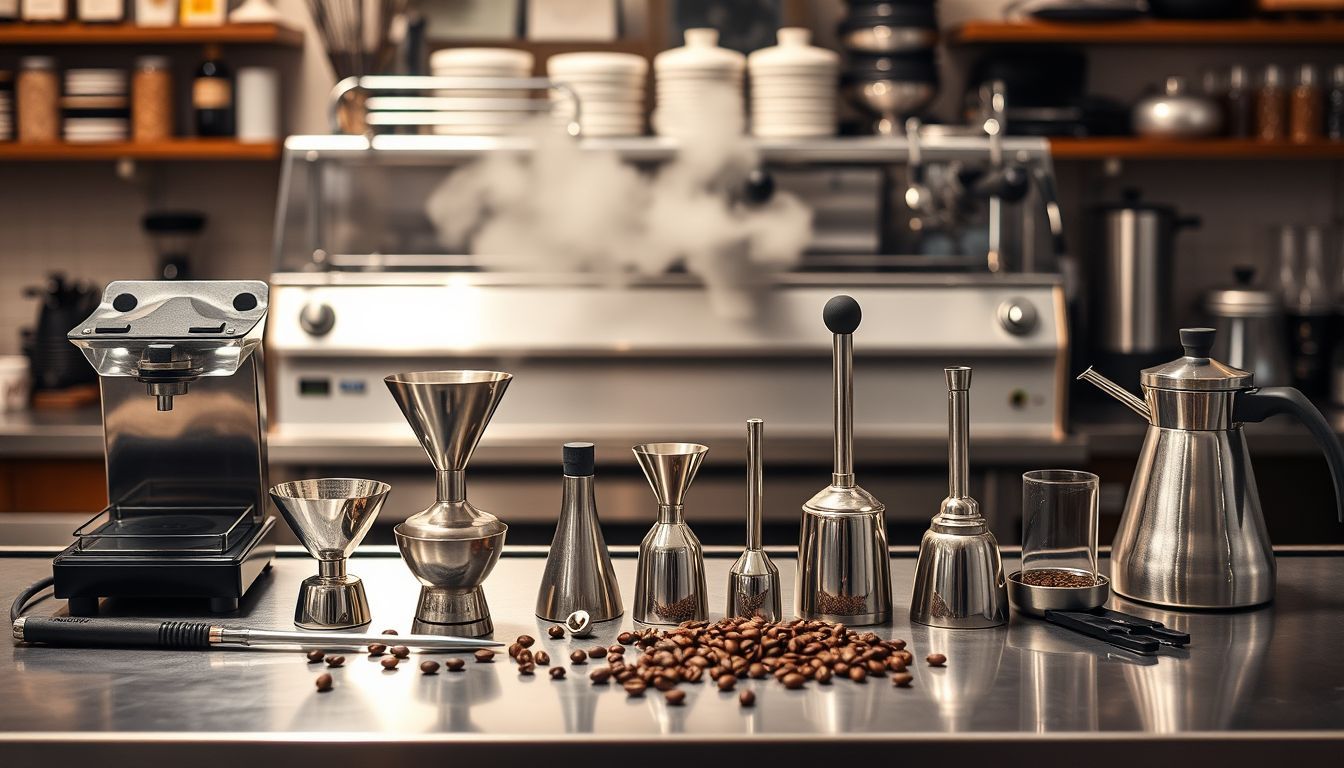Best Coffee Equipment for Making Café-Quality Drinks at Home
Transform your kitchen into a professional café with expert-tested equipment. From espresso machines to milk steamers, discover the gear that delivers barista-quality drinks at home.

Amazon Affiliate Disclosure
This post contains affiliate links. If you purchase through these links, we may earn a small commission at no additional cost to you.
Best Coffee Equipment for Making Café-Quality Drinks at Home
Last week, I watched a friend spend $47 on coffee shop drinks over three days—two cortados, a flat white, and what the barista generously called a “signature latte” but tasted suspiciously like overpriced milk with a coffee rumor. When I mentioned that the same money could buy enough quality beans for a month of home brewing, she sighed and said, “But I can’t make drinks like this at home.”
Challenge accepted.
The truth is, café-quality drinks at home aren’t just possible—they’re inevitable once you understand the equipment fundamentals. The gap between professional and home coffee has never been smaller, thanks to accessible technology and better understanding of extraction science. You don’t need a $20,000 commercial setup to pull shots that would make your local barista weep with envy.
After years of testing everything from $200 starter machines to $4,000 prosumer beasts, I’ve identified the equipment that actually delivers on the café-quality promise. Some might surprise you with their simplicity, others with their sophistication, but all share one trait: they produce drinks that justify canceling your coffee shop subscription.
Understanding Café-Quality: What Are We Actually Chasing?
Before diving into equipment recommendations, let’s define our target. Café-quality isn’t just about taste—it’s about the complete sensory experience that makes you pause mid-sip and think, “This is exactly what coffee should be.”
The Hallmarks of Professional Coffee
Espresso Excellence: Rich crema, balanced extraction, and that perfect marriage of sweetness and intensity that makes you understand why Italians are so particular about their coffee.
Milk Texture Mastery: Microfoam so silky it pours like liquid velvet, creating latte art that’s Instagram-worthy and, more importantly, enhances the drinking experience.
Consistency: The same excellent result every single time, not just when the coffee gods smile upon your morning routine.
Temperature Precision: Drinks served at optimal temperature, not lukewarm disappointments or tongue-scorching accidents.
The Home Advantage
Here’s what most people don’t realize: home brewing has inherent advantages over commercial settings. You control every variable, from bean freshness to water quality. You’re not rushing through a morning rush or dealing with equipment that’s been running non-stop since 5 AM. When done right, home café drinks can actually surpass commercial quality.
Essential Equipment Categories for Café-Quality Drinks
Espresso Machines: The Heart of the Operation
Entry-Level Excellence: Breville Bambino Plus ($300)
Don’t let the price fool you—this compact machine punches well above its weight class. The Bambino Plus delivers genuine 9-bar espresso pressure and automatic milk frothing that produces café-quality microfoam.
What makes it special:
- 3-second heat-up time (faster than most commercial machines)
- Automatic milk texturing with temperature control
- Compact footprint perfect for small kitchens
- Consistent extraction pressure
Real-world performance: I’ve pulled hundreds of shots on this machine, and while it won’t satisfy every espresso obsessive, it consistently produces drinks that rival neighborhood coffee shops. The automatic milk steaming is particularly impressive—better than many manual steam wands I’ve used. For most home baristas, it’s all you need to say goodbye to the local espresso line.
We recommend pairing it with the Breville Bambino Plus Espresso Machine BES450BSS to kickstart your café-quality journey.
Mid-Range Marvel: Rancilio Silvia Pro X ($1,600)
This machine represents the sweet spot between accessibility and professional capability. Dual boilers mean simultaneous brewing and steaming, while PID temperature control ensures extraction consistency.
Professional features: dual boiler system for simultaneous operations; PID temperature control (±1 °F accuracy); commercial-grade group head; professional steam wand with excellent power. Why it excels: the Silvia Pro X eliminates the waiting game that plagues single-boiler machines. Pull a shot, steam milk immediately, and serve drinks at optimal temperature.
Prosumer Powerhouse: Decent Espresso DE1+ ($3,500)
For the ultimate in home espresso technology, the Decent represents the cutting edge. Tablet-controlled brewing, pressure profiling, and data logging that would make a scientist weep with joy.
Advanced capabilities: pressure profiling throughout extraction; real-time flow rate monitoring; temperature control to 0.1 °C; Bluetooth connectivity and app control. The reality check: this machine is for serious enthusiasts who view espresso as both beverage and science experiment.
Grinders: The Unsung Heroes of Great Coffee
The Espresso Specialist: Eureka Mignon Specialita ($420)
Espresso demands grind consistency that most grinders simply can’t deliver. The Specialita’s 55 mm flat burrs and stepless adjustment make it the entry point for serious espresso grinding.
Technical advantages: stepless micrometric adjustment; low retention design (minimal coffee waste); quiet operation; consistent particle size distribution. Performance notes: The difference between this grinder and a $150 alternative is immediately apparent in the cup.
The All-Rounder: Baratza Encore ESP ($140)
While primarily designed for filter coffee, the Encore’s 40 mm conical burrs and 40-position adjustment make it surprisingly capable for espresso with careful dialing in.
Versatility factors: 40 grind settings; 40 mm conical burrs for consistent particle size; easy-to-access burrs for cleaning; compact footprint perfect for tight spaces.
For a budget-friendly, reliable grinder that can grow with your skills, check out the Baratza Encore Coffee Grinder ZCG495BLK.
The Investment Piece: Mahlkönig X54 ($900)
When you’re ready to eliminate grind quality as a variable entirely, the X54 delivers commercial-grade consistency in a home-friendly package.
Professional features: 54 mm flat burrs; exceptional grind uniformity; low retention and easy cleaning; built to last decades.
Milk Steaming and Frothing Solutions
Manual Steam Wands: The Traditional Approach
Most quality espresso machines include steam wands, but technique makes the difference between café-quality microfoam and disappointing bubbles.
Automatic Alternatives: Nespresso Aeroccino 3 Milk Frother ($70)
For those who want café-quality milk texture without the learning curve, dedicated milk frothers can deliver excellent results. The Aeroccino 3 creates warm or cold milk foam at the touch of a button, making it a perfect companion for any espresso source.
Advantages: consistent temperature control; multiple texture settings; no technique required; works with any espresso source. Limitations: less control over final texture, and another appliance to store and clean.
Simplify your milk-texturing routine with the Nespresso Aeroccino 3 Milk Frother.
Scales and Precision Tools
Espresso Scales: Acaia Lunar ($220)
Precision matters in espresso, where 1-2 grams can dramatically affect extraction. The Lunar’s fast response time and water resistance make it ideal for espresso workflows.
Essential features: 0.1 g precision with fast response; built-in timer for shot timing; water-resistant design; compact footprint for espresso workflows.
For budget-minded precision, the KitchenTour Coffee Scale with Timer, 3 kg/0.1 g High Precision is an excellent alternative.
Dosing and Distribution: Decent Tamper ($85)
Even distribution and consistent tamping pressure affect extraction uniformity. Quality tools make consistent technique easier.
Professional accessories: calibrated tamper for consistent pressure; distribution tools for even coffee bed; precision baskets for improved extraction.
Complete Setup Recommendations by Budget
The Starter Setup ($800 total)
- Breville Bambino Plus Espresso Machine BES450BSS: $300
- Baratza Encore Coffee Grinder ZCG495BLK: $140
- KitchenTour Coffee Scale, 3 kg/0.1 g: $40
- Basic tamper and accessories: $120
- Premium beans & accessories: $200
What you get: Genuine espresso capability with automatic milk frothing. This setup produces drinks that rival most coffee shops, with room to grow your skills.
The Enthusiast Setup ($2,500 total)
- Rancilio Silvia Pro X: $1,600
- Eureka Mignon Specialita: $420
- Acaia Lunar scale: $220
- Professional accessories: $200
- Premium beans: $60
What you get: Professional-level capability with dual boilers and precision grinding. This setup eliminates most equipment limitations, making technique the primary variable.
The No-Compromise Setup ($5,000+ total)
- Decent DE1+ or similar: $3,500
- Mahlkönig X54: $900
- Professional accessories: $300
- Premium setup and training: $300+
What you get: Equipment that exceeds most commercial setups, with precision and control that enables experimentation and perfection.
Beyond Equipment: The Skills That Matter
Espresso Fundamentals
- Dose Consistency: Use the same amount of coffee every time (typically 18–20 g for double shots).
- Grind Adjustment: Learn to adjust grind size based on extraction time and taste.
- Tamping Technique: Level, consistent pressure creates even extraction.
- Shot Timing: Aim for 25–30 second extractions for balanced flavor.
Milk Steaming Mastery
- Temperature Control: 140–150 °F for optimal sweetness and texture.
- Texture Creation: Microfoam should be silky, not bubbly.
- Integration: Proper swirling creates homogeneous milk texture.
- Pouring Technique: Steady flow and pitcher control enable latte art.
Water Quality and Bean Selection
- Water Matters: Filtered water with appropriate mineral content enhances extraction.
- Bean Freshness: Use beans roasted within 2–4 weeks for optimal flavor.
- Storage: Airtight containers preserve bean quality.
- Experimentation: Try different origins and roast levels to find preferences.
Common Mistakes That Sabotage Café Quality
Equipment Errors
- Undersized Grinders: Blade grinders or inadequate burr grinders limit quality regardless of other equipment.
- Temperature Instability: Machines without temperature control produce inconsistent results.
- Inadequate Pressure: True espresso requires 9 bars of pressure—anything less is strong coffee, not espresso.
Technique Problems
- Inconsistent Dosing: Varying coffee amounts make consistent results impossible.
- Poor Tamping: Uneven tamping creates channeling and uneven extraction.
- Overheated Milk: Milk above 160 °F tastes scalded and loses sweetness.
- Stale Beans: Even perfect technique can’t overcome old, stale coffee.
The Economics of Home Café Quality
Let’s address the elephant in the room: initial equipment costs seem high compared to buying coffee shop drinks. But the math is compelling for regular coffee drinkers.
Break-even analysis:
- Daily $5 latte = $1,825 annually
- Quality home setup ($2,500) + beans ($300/year) = break-even in 18 months
- Years 2+ = pure savings plus better coffee
Hidden benefits:
- Convenience of home brewing
- Control over ingredients and quality
- Skill development and satisfaction
- Impressive guests (never underestimate this factor)
Maintenance and Longevity
Quality equipment requires care but rewards maintenance with years of excellent service.
Daily Maintenance
- Rinse and wipe down after use
- Empty drip trays and water reservoirs
- Purge steam wands after milk steaming
Weekly Maintenance
- Deep clean removable parts
- Check and clean grinder burrs
- Descale as needed (varies by water hardness)
Professional Service
- Annual professional cleaning and calibration
- Burr replacement every 2–3 years
- Preventive maintenance extends equipment life significantly
Conclusion: Your Café Awaits
Creating café-quality drinks at home isn’t about replicating every aspect of commercial coffee service—it’s about understanding what makes great coffee great and investing in the tools that deliver those results consistently.
The equipment I’ve recommended represents tested solutions that bridge the gap between aspiration and achievement. Whether you start with the Bambino Plus setup or jump directly to prosumer equipment, each represents a significant upgrade over typical home coffee experiences.
Remember: equipment enables great coffee, but doesn’t guarantee it. The best espresso machine in the world won’t compensate for stale beans, poor technique, or inconsistent practice. Start with quality equipment, invest time in learning proper technique, and be patient with the learning process.
The reward—that first perfect cortado you make at home, with silky microfoam and balanced espresso that rivals your favorite café—makes every dollar and every practice session worthwhile. You’ll never look at coffee shop prices the same way again.
What’s your experience with home espresso equipment? Have you found any machines or techniques that consistently deliver café-quality results? I’m always interested in hearing about real-world experiences with home coffee setups.

Sofia Rossi
I started my career in a world of spreadsheets and boardrooms, but I quickly realized the most interesting data was in the way people interacted when the pressure was on. My novels are my way of analyzing the human heart—the messy, complicated, and often hilarious parts. I write about the lives we lead now, with all the love, ambition, and absurdity that comes with it.


